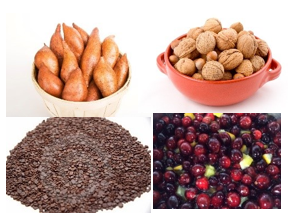
by Ginny Hinton | Jun 30, 2017
 Driving to work this morning, I had to swerve to miss a driver who had crossed the center line. Thankfully, I was paying attention and he got back in his lane fairly quickly, so no one was hurt. I suspect the other driver never realized that he almost had a close encounter of the dangerous kind.
Driving to work this morning, I had to swerve to miss a driver who had crossed the center line. Thankfully, I was paying attention and he got back in his lane fairly quickly, so no one was hurt. I suspect the other driver never realized that he almost had a close encounter of the dangerous kind.
We’ve all heard the warning: driving while texting can be a deadly distraction. The problem is that most of us live fairly hectic lives. We may not intend to talk or text while we drive but the temptation to multi-task can be overwhelming – especially when we’re under a deadline. And honestly? Most of us think our driving skills are a shade above average and we can cope with a little distraction.
The hard truth is that cell phone use, especially texting, is “associated with the highest levels of driving performance degradation.” Even the most experienced texting driver takes twice as long to react, making texting a seriously dangerous activity. Around 69% of drivers, ages 18-64, report having used their phones while driving over the past 30 days. With over 9 people killed and 1,060 injured every day due to distracted driving, that’s a major problem.
So, what makes texting and driving so dangerous? You may have heard that the average texting driver takes his or her eyes off the road for an average of 5 seconds. At 55 mph, that’s like traveling the length of a football field blindfolded. What you may not know is that there are three distinct forms of driving distraction:
- Visual (requires driver to look away from the road)
- Manual (requires driver to take a hand or hands off the wheel to manipulate an object)
- Cognitive (thinking about something other than driving)3
According to the National Highway Traffic Safety Administration, texting is among the worst of driver distractions because it involves all three forms at the same time. With over 320 million cell phone subscriptions in the US today, it’s a problem that continues to grow.
Only you can make the decision to be an alert driver. Choosing to focus on your driving makes you better – and safer – while sharing the road.
Sources:
- Vegega, M., Jones, B., & Monk, C. (2013, December). Understanding the effects of distracted driving and developing strategies to reduce resulting deaths and injuries: A report to Congress (Report No. DOT HS 812 053). Washington, DC: National Highway Traffic Safety Administration.
- Cooper, J., Yager, C., Chrysler, S., (2011, August). An Investigation of the Effects of Reading and Writing Text-based Messages While Driving. Southwest Region University Transportation Center: Texas Transportation Institute.
- What Is Distracted Driving?, 2017, National Highway Traffic Safety Administration. http://nhtsa.gov/risky-driving/distracted-driving#34621.
by Ginny Hinton | Apr 3, 2017

Simplify your life. What an easy thing to say! Unfortunately, sometimes putting those words into action can be anything but easy. For so many of us, things just seem to accumulate until clutter becomes a way of life. In fact, most Americans only use 20% of what we own. The other 80% consists of things we don’t use, think we ought to use or might use someday. This kind of clutter can take over a home, turning a peaceful retreat into a stressful out-of-control environment.
It’s a fact. Disorganization causes 80% of the clutter in most homes. Becoming more organized and ditching the clutter can do wonders for lowering stress and improving physical, mental and emotional health. Organization puts you in control of your environment, opens up more time for yourself and even saves you money by eliminating those unnecessary last-minute purchases.
Professional Organizer Peter Walsh offers the following “FAST” tips for getting rid of clutter:
F: Fix a time. Eliminating clutter isn’t something you need to do all by yourself. Make it a family affair and get even more done. Pick a weekend day or a couple of hours every day when everyone is home and get a jump start on the process.
A: Anything not used in 12 months. If you haven’t used something in the last year, you probably don’t need it. There are lots of strategies for narrowing down what can be thrown away versus what needs to be kept. One idea with clothes is to point all hangers in one direction. As you wear an item, turn the hanger in the opposite direction. By the end of the season, you’ll be able to tell exactly which clothes you need to bid a fond farewell.
S: Someone else’s stuff. This one is easy. Your house shouldn’t contain anything that doesn’t belong to you. If it doesn’t belong to you, don’t keep it in your house.
T: Trash. Make the trash can your hungry friend – and feed it. Be proud of how much you purge and keep your goal in sight: Only save the amount of stuff that makes sense for your space.
When it comes to “clutter busting”, put strategy into action and you’ll soar. Take advantage of online search engines to find even more tips and tricks. Before you know it, you’ll be amazed at what you’ve accomplished.
References:
Declutter Your Life, UF/IFAS Extension, Seminole County, Julie England. 2016
Getting Organized, West Virginia University Extension Service Families and Health Programs, Stephanie Nestor and Zona Hutson. 2010
Get Organized Now Website http://www.getorganizednow.com/
Peter Walsh http://www.oprah.com/home/Clutter-Control
by Ginny Hinton | Nov 25, 2016
As we head into the season of overindulgence, it’s good to know that some holiday “treats” can actually be nutritiously guilt-free if we eat them in moderation. Read on to find the hidden health benefits of some classic favorites.
Sweet Potatoes: Sure, it’s a no-brainer that sweet potatoes are a source of vitamins, but these super veggies may be even better for you than you think! Your body converts the alpha and beta carotene from sweet potatoes into Vitamin A, helping keep your eyes, bones and immune system in top shape. Choose firm sweet potatoes with tapered ends and a uniform shape and color.
 Nuts: Even though nuts are high in calories and fat, they are loaded with vitamins and minerals. The fat in nuts is heart-healthy. In fact, research suggests that eating just a handful of nuts a few times a week may lower heart disease risk. Nuts are also a great source of antioxidants, energy and protein. You might consider nuts a Christmas gift to your body!
Nuts: Even though nuts are high in calories and fat, they are loaded with vitamins and minerals. The fat in nuts is heart-healthy. In fact, research suggests that eating just a handful of nuts a few times a week may lower heart disease risk. Nuts are also a great source of antioxidants, energy and protein. You might consider nuts a Christmas gift to your body!
Cocoa: Who doesn’t love a steaming cup of hot cocoa? Now, we know that its health benefits give us even more reason to love it. For example, cocoa contains antioxidants called flavonoids that may lower the risk of heart attack or stroke. Dark chocolate with a high percent of cocoa solids may help lower blood pressure, improve blood vessel health, and regulate cholesterol levels. So, give in to your craving – in moderation, of course!
Cranberries: With their rich red color, cranberries add a festive touch to any holiday table. Beautiful cranberries contain only 45 calories per cup while offering a healthy dose of benefits. They’re a good source of vitamin C and fiber, and they outrank nearly every other fruit and vegetable in the amount of disease fighting antioxidants they contain. Buy cranberries fresh in fall and winter and store them in a tightly sealed bag in your refrigerator to keep them fresh longer.
References:
EatingWell. Surprisingly Healthful Seasonal Treats. http://recipes.millionhearts.hhs.gov/articles/surprisingly-healthful-seasonal-treats
Hendrick, Bill. Cocoa Rich in Health Benefits. WebMD Health News. March 23,2011. http://www.webmd.com/diabetes/news/20110323/cocoa-rich-in-health-benefits
Lerch Davis, Jeanie. Cranberries, Year-round Superfood. Web MD Feature. 9/29/2009. www.webmd.com/food-recipes/features/cranberries-year-round-superfood.
Mayo Clinic Staff. Nuts & your heart: Eating nuts for heart health. 9/15/2016. www.mayoclinic.org.

by Ginny Hinton | Nov 25, 2016
 It’s a fact. We need salt in our diets. Our bodies need sodium, which we usually get through salt, to maintain fluid balance and blood volume. Unfortunately, most of us consume at least twice as much sodium as we need.
It’s a fact. We need salt in our diets. Our bodies need sodium, which we usually get through salt, to maintain fluid balance and blood volume. Unfortunately, most of us consume at least twice as much sodium as we need.
The main culprit for sodium intake is not the salt we sprinkle on food, nor is it the salt we use when we cook. It’s the processed foods we grab to make meal preparation quicker and easier – the breads, soups, pizza, cheese, snacks, and more. For example, most of us require only 1,500 mg of sodium, or ¾ teaspoon, per day. Just one slice of a typical frozen pizza contains more than half that amount.
It’s a good idea to buy fresh, frozen, or low sodium veggies, choose roasted meats over processed lunch meats, and read labels to find low sodium choices when possible. How do you know your item is low sodium? It should contain 140 mg or less of sodium per typical serving. If that’s hard to remember, just look for foods with a Daily Value (DV) of 5% or less.
Soup is one of the worst offenders when it comes to sodium content. Unfortunately, when commercial soups are cooked at a high temperature long enough to kill potentially harmful bacteria, the soups lose some of their flavor. Salt offers a cheap and easy way to make up for that loss. Still, many soups can be a great choice, especially if you’re counting calories. How can you enjoy a quick cup of soup without loading up on the salt? Start with a can of light or reduced sodium soup then add your favorite fresh or unseasoned frozen veggies. You’ll still get more sodium than you would with homemade soup but you’ll get much less than in typical canned soup, with an added nutrient and fiber boost.
With a few changes, you can reduce your sodium and still enjoy tasty meals!
References:
University of Florida IFAS Extension, Keeping the Pressure Down, Lesson 4: DASH Diet – Balancing Minerals.
Dahl W & Foster L. Shopping for Health: Sodium
Nutrition Action, Do You Want to Discover Ways to Cut Salt from Your Diet? 10/17/2016
by Ginny Hinton | Sep 25, 2016
With an alarming divorce rate that has rapidly escalated during the last half of the 20th century, many couples are part of a growing group focusing on developing a healthy marriage. Research shows that there is a clear link between a healthy marriage and better health for men and women. Children also grow and thrive when the relationship between their parents is strong. What then, are the keys to building a long-lasting, healthy relationship?
It is important to not buy into prevalent marriage myths, such as “Never go to bed angry” or “If we have a big disagreement, our relationship is doomed”. Another common myth is, “Marriage should be a 50/50 relationship”. These myths can build unrealistic expectations. If you ever feel like your relationship is “not going the way it is supposed to”, check to make sure you’re not buying into an idealistic myth about marriage.
According to the latest research, there are three major factors that largely influence marital satisfaction.
 Couple Traits and Interactions include communication and intimacy. Intimacy is a combination of affection, sexual relations, emotional closeness from time spent together and the ability to be open and vulnerable with each other.
Couple Traits and Interactions include communication and intimacy. Intimacy is a combination of affection, sexual relations, emotional closeness from time spent together and the ability to be open and vulnerable with each other.
- Individual Traits and Behavior include taking care of our own social, emotional and spiritual needs. Paying attention to personal needs contributes to satisfaction within the marriage.
- Background and Contexts serve as the foundation for building the other traits. They include everything each partner brings to the marriage, for example: individual backgrounds, values, culture, etc. plus qualities of the marriage itself such as how the partners deal with money issues and in-laws.
Marriages grow and change throughout the relationship. Understanding and practicing the key skills involved in building a marriage can help create a more joyful and fulfilling journey.
For more information about building a healthy and strong marriage, visit SMARTcouples.org.
Adapted from “10 Things You Need to Know Before You Get Married”, by Victor W. Harris and Ginny Hinton, 2012. http://www.edis.ifas.ufl.edu document FCS2319.

 Driving to work this morning, I had to swerve to miss a driver who had crossed the center line. Thankfully, I was paying attention and he got back in his lane fairly quickly, so no one was hurt. I suspect the other driver never realized that he almost had a close encounter of the dangerous kind.
Driving to work this morning, I had to swerve to miss a driver who had crossed the center line. Thankfully, I was paying attention and he got back in his lane fairly quickly, so no one was hurt. I suspect the other driver never realized that he almost had a close encounter of the dangerous kind.




